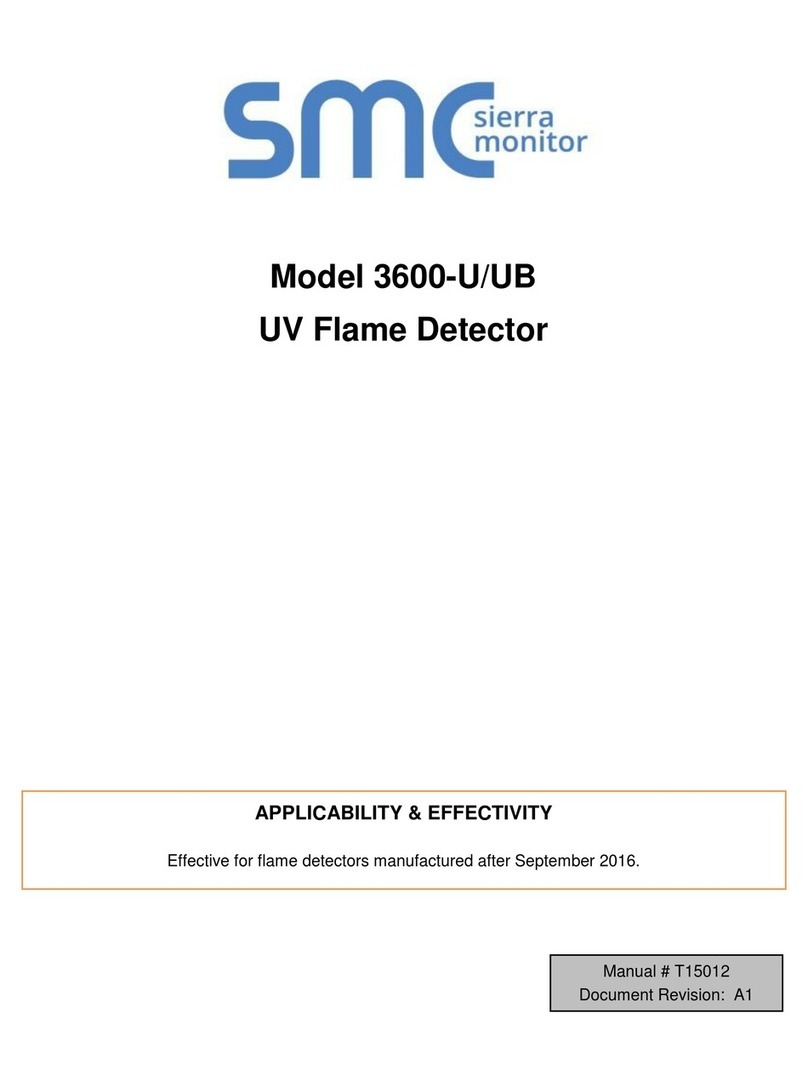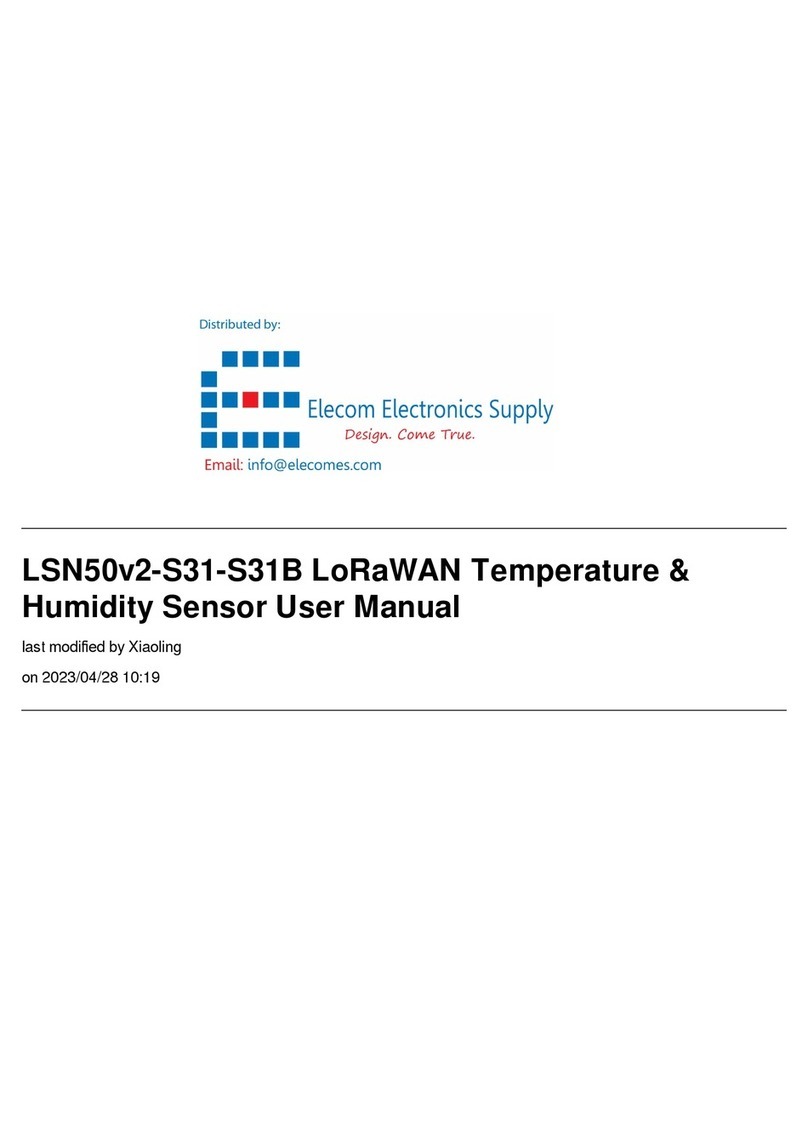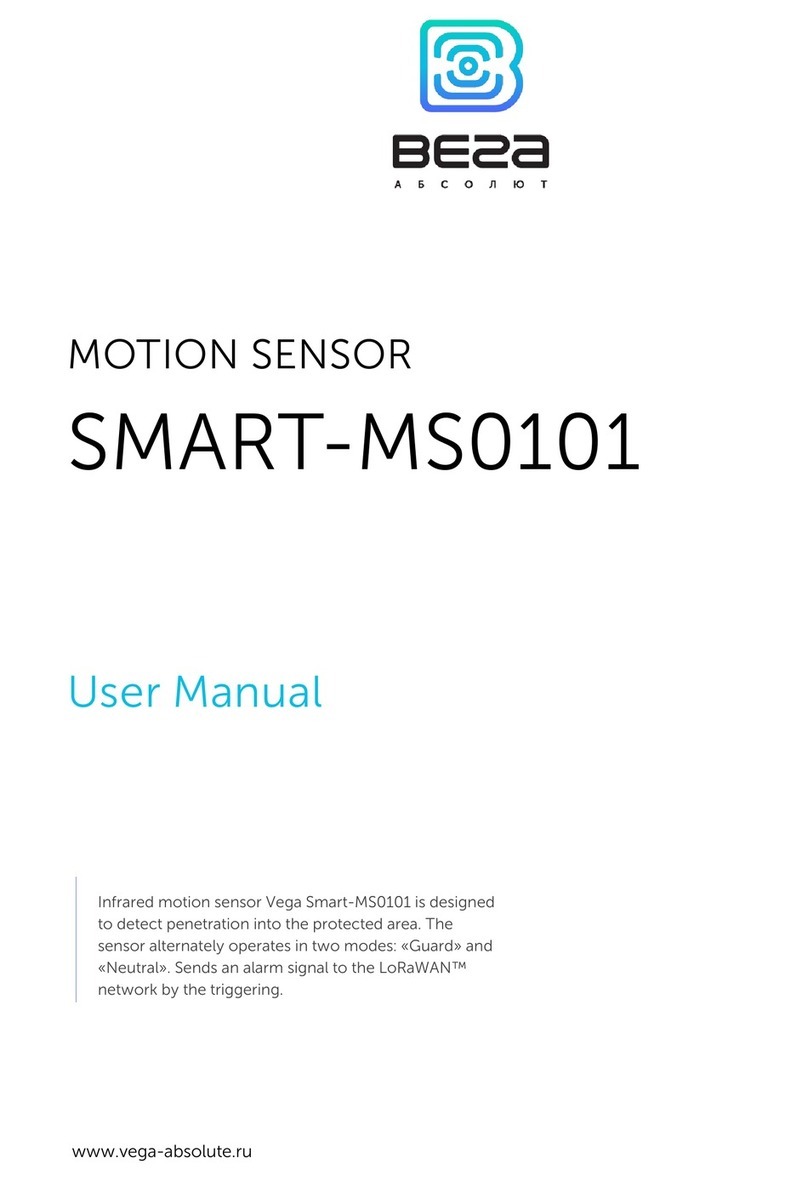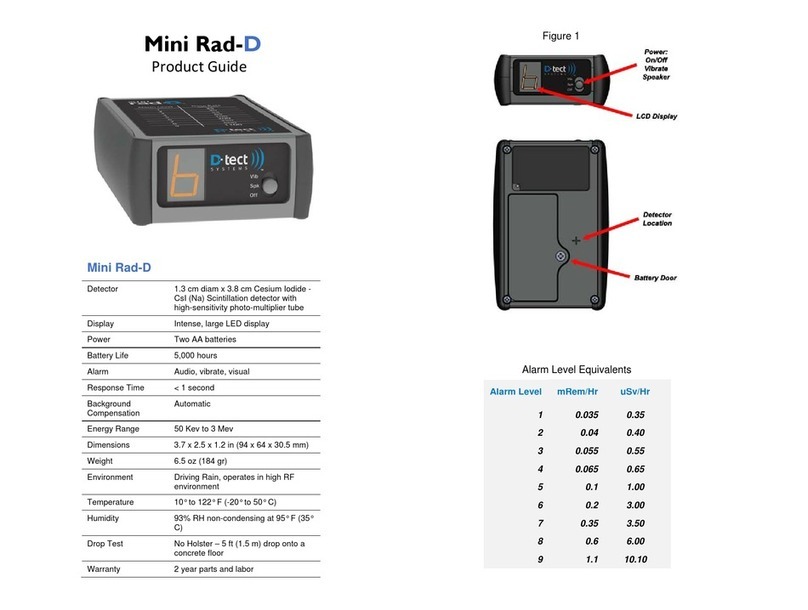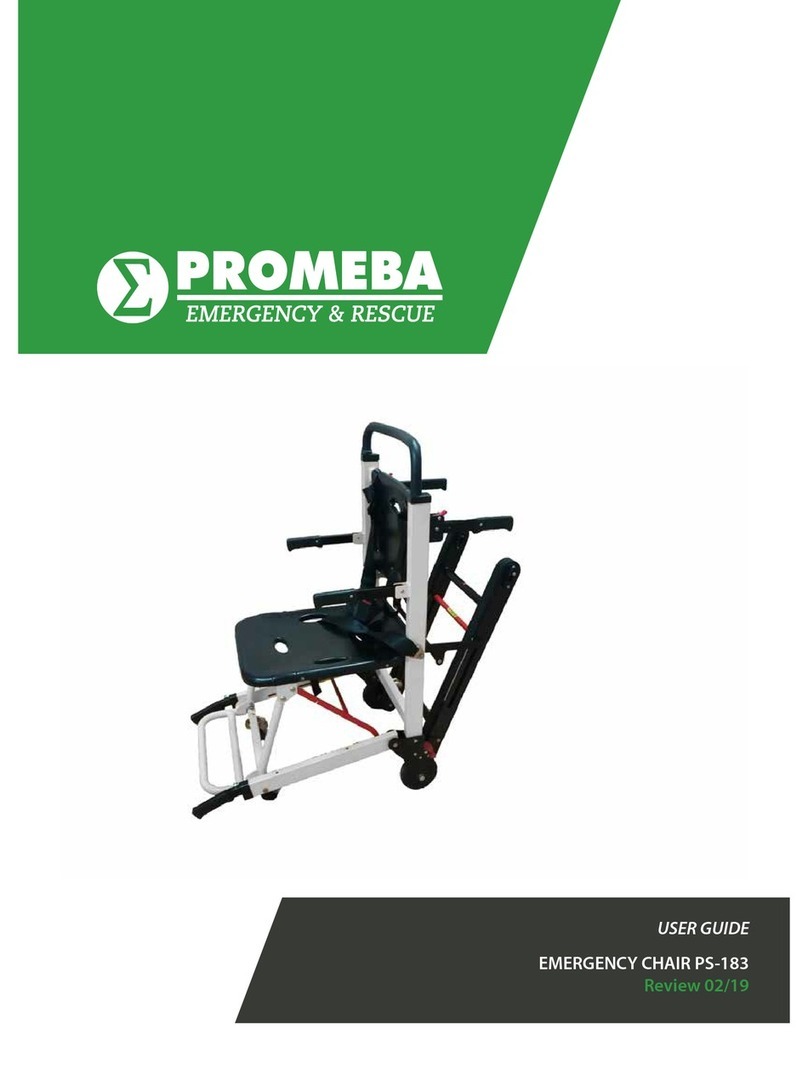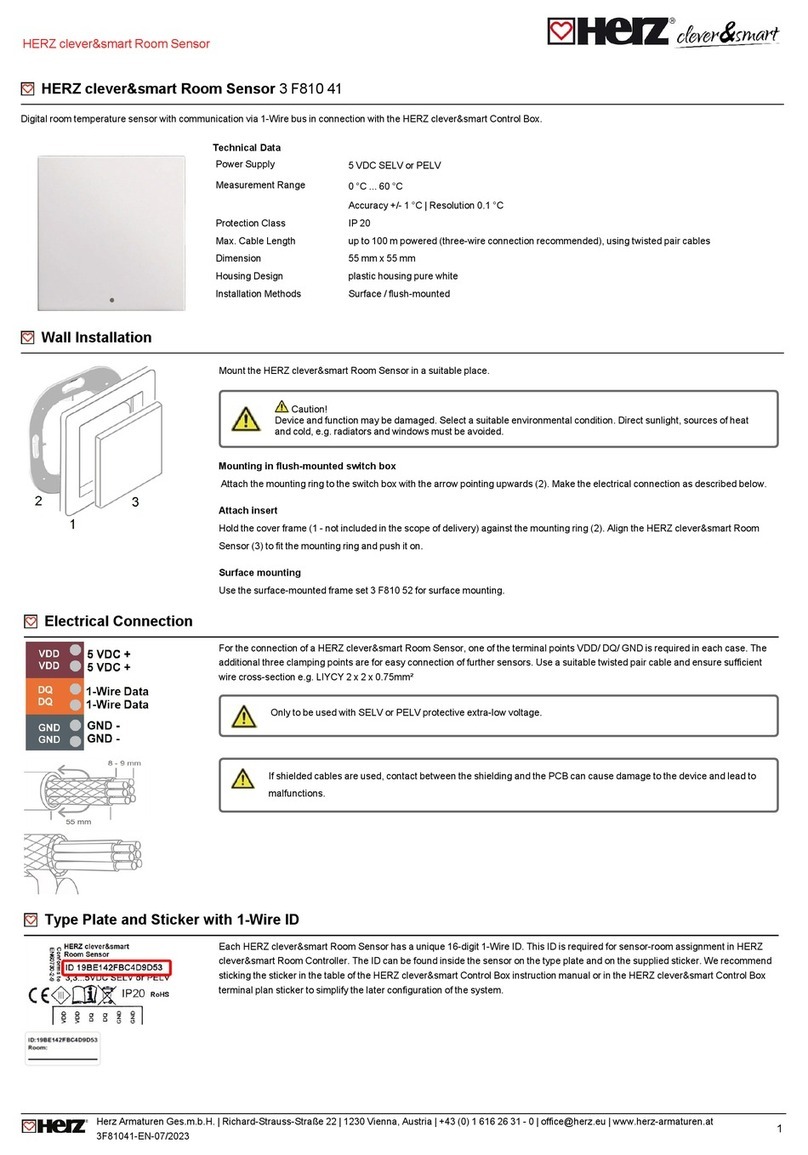SMC Sierra Monitor 3600-I User manual

Manual # T15014
Document Revision: A1
Model 3600-I
Triple IR (IR3) Flame Detector
APPLICABILITY & EFFECTIVITY
Effective for flame detectors manufactured after September 2016.

Model 3600-I IR3 Flame Detector
Contact Information
©2016 Sierra Monitor. All rights reserved.
Manual Number: T15014
This manual contains intellectual property that was developed by Sierra Monitor Corporation Inc.
and is protected by the copyright laws of the United States, international copyright treaties, and
all other applicable national laws. This manual contains information regarding technology that is
protected under one or more issued or pending United States and foreign patents.
Sierra Monitor and Sentry IT are trademarks of Sierra Monitor Corporation. All other trademarks
are the property of their respective owners.
This manual is licensed to users of Sierra Monitor products and may be copied, in whole or in
part.
The offices of Sierra Monitor are located at:
Sierra Monitor Corporation
1991 Tarob Court
Milpitas, CA 95035
USA
Customer Service:
Telephone: (408) 262-6611
Fax: (408) 262-9042
Toll-Free: (800) 727-4377
Email: support@sierramonitor.com
Website: www.sierramonitor.com

Model 3600-I IR3 Flame Detector
Page 3 of 66
ABOUT THIS GUIDE
This guide describes the Model 3600-I Triple IR (IR3) Flame Detector along with their features.
Additionally, the guide provides instructions on how to install, operate and maintain the detector.
This guide includes the following Sections and appendixes:
Section 1 –Introduction: a general overview of the product, principles of operation and
performance considerations.
Section 2 –Installing the Detector: how to install the detector including preparations before
installation, wiring and mode settings.
Section 3 –Operating the Detector: how to power-up and test the detector; also listing
safety precautions to take when operating the detector.
Section 4 –Maintenance and Troubleshooting: basic maintenance procedures,
troubleshooting and support procedures.
Appendix A –Technical Specifications: the detector’s technical specifications.
Appendix B –Wiring Instructions: wiring instructions for connecting the detector and
provides examples of typical wiring configurations.
Appendix C –RS-485 Communication Network: an overview of the RS-485
communications network.
Appendix D –Accessories: the accessories available for the detector.
Appendix E –SIL-2 Features: the special conditions to comply with the requirements of EN
61508 for SIL 2 according to TÜV.

Model 3600-I IR3 Flame Detector
Page 4 of 66
ABBREVIATIONS AND ACRONYMS
Abbreviation
Meaning
ATEX
Atmosphere Explosives
AWG
American Wire Gauge
BIT
Built In Test
EMC
Electromagnetic Compatibility
EOL
End of Line
FOV
Field of View
HART
Highway Addressable Remote Transducer-communication protocol
IAD
Immune at Any Distance
IECEx
International Electrotechnical Commission Explosion
IPA
Isopropyl Alcohol
IR
Infrared
JP4
Jet Fuel
Latching
Refers to relays remaining in the ON state even after the ON condition has been removed
LED
Light Emitting Diode
LPG
Liquefied Petroleum Gas
mA
MilliAmps (0.001 amps)
Modbus
Master-slave messaging structure
N.C.
Normally Closed
N.O.
Normally Open
N/A
Not Applicable
NFPA
National Fire Protection Association
NPT
National Pipe Thread
SIL
Safety Integrity Level
UNC
Unified Coarse Thread
VAC
Volts Alternating Current
Figure 1: List of Terms

Model 3600-I IR3 Flame Detector
Table of Contents
TABLE OF CONTENTS
About this Guide .........................................................................................................................................3
Abbreviations and Acronyms ....................................................................................................................4
Introduction..........................................................................................................................................911.1 Overview.........................................................................................................................................9
1.2 Model and Types..........................................................................................................................10
1.3 Features and Benefits...................................................................................................................12
1.4 Principles of Operation .................................................................................................................12
1.4.1 Hydrocarbon Fire Detection ..................................................................................................13
1.4.2 Heated Optics........................................................................................................................13
1.4.3 HART Protocol.......................................................................................................................14
1.4.4 RS-485 Modbus.....................................................................................................................14
1.4.5 Product Certification..............................................................................................................14
1.4.6 ATEX and IECEx...................................................................................................................14
1.4.6.1 SIL-2 Approved (TÜV)....................................................................................................14
1.5 Performance Considerations........................................................................................................15
1.5.1 Detection Sensitivity..............................................................................................................15
1.5.1.1 Standard Fire .................................................................................................................15
1.5.1.2 Sensitivity Ranges..........................................................................................................15
1.5.1.3 Other Fuels.....................................................................................................................16
1.5.2 Cone of Vision.......................................................................................................................17
1.5.3 False Alarms Prevention .......................................................................................................18
1.5.4 Visual Indicators....................................................................................................................19
1.5.5 Output Signals.......................................................................................................................20
1.5.6 Detector Status......................................................................................................................21
1.5.6.1 Optional Latching ...........................................................................................................22
1.5.7 Auxiliary Relay as End-of-Line Resistor................................................................................22
1.6 Internal Detector Tests .................................................................................................................23
1.6.1 Continuous Feature Test.......................................................................................................23
1.6.2 Built-In-Test (BIT)..................................................................................................................24
1.6.2.1 How the BIT Operates....................................................................................................24
1.6.2.2 Automatic BIT.................................................................................................................24
1.6.2.3 Manual BIT.....................................................................................................................25
1.6.2.4 Manual BIT Only Selected .............................................................................................25
Installing the Detector.......................................................................................................................2622.1 General Guidelines.......................................................................................................................26
2.2 Unpacking the Product .................................................................................................................27
2.2.1 Checking the Product Type...................................................................................................27
2.3 Required Tools .............................................................................................................................27
2.4 Certification Instructions ...............................................................................................................27
2.5 Installation Cables ........................................................................................................................28
2.5.1 Conduit Installation................................................................................................................28
2.6 Installing the Tilt Mount (part no. 3600-001).................................................................................29
2.6.1 Tilt Mount Specifications .......................................................................................................29
2.6.2 Tilt Mount Assembly..............................................................................................................30
2.7 Connecting the Detector...............................................................................................................32
2.7.1 Verifying the Detector Wiring.................................................................................................33
2.8 Configuring the Detector...............................................................................................................34
2.8.1 Sensitivity ..............................................................................................................................35
2.8.2 Alarm Delay...........................................................................................................................35
2.8.3 Address Set-up......................................................................................................................35
2.8.4 Function Set-up.....................................................................................................................36
2.8.5 Heated Optics........................................................................................................................36

Model 3600-I IR3 Flame Detector
Table of Contents
Operating the Detector......................................................................................................................3733.1 Powering Up.................................................................................................................................37
3.2 Safety Precautions........................................................................................................................37
3.2.1 Default Functions Settings ....................................................................................................38
3.3 Testing Procedures.......................................................................................................................38
3.3.1 Automatic BIT Test................................................................................................................38
3.3.2 Manual BIT Test....................................................................................................................39
3.3.3 Testing with Fire Simulator Model FS-1100..........................................................................39
Maintenance and Troubleshooting..................................................................................................4044.1 Maintenance .................................................................................................................................40
4.1.1 General Procedures ..............................................................................................................40
4.1.1.1 Cleaning.........................................................................................................................40
4.1.2 Periodic Procedures..............................................................................................................40
4.1.2.1 Power-Up Procedure......................................................................................................40
4.1.2.2 Functional Test Procedure.............................................................................................40
4.1.3 Keeping Maintenance Records.............................................................................................41
4.2 Troubleshooting............................................................................................................................41
Appendix A. Specifications......................................................................................................................43
Appendix A.1. Technical Specifications ..................................................................................................43
Appendix A.2. Electrical Specifications ...................................................................................................43
Appendix A.3. Outputs.............................................................................................................................44
Appendix A.4. Mechanical Specifications................................................................................................46
Appendix A.5. Dimensions ......................................................................................................................46
Appendix A.6. Weight..............................................................................................................................46
Appendix A.7. Environmental Specifications...........................................................................................47
Appendix B. Wiring Instructions .............................................................................................................48
Appendix B.1. General Instructions for Electrical Wiring.........................................................................48
Appendix B.2. Typical Wiring Configurations..........................................................................................49
Appendix C. RS-485 Communication Network ......................................................................................53
Appendix C.1. RS-485 Overview.............................................................................................................53
Appendix D. Accessories.........................................................................................................................54
Appendix D.1. Long Range IR3 Fire Simulator.......................................................................................54
Appendix D.1.1. Unpacking .................................................................................................................54
Appendix D.1.2. Operating Instructions...............................................................................................55
Appendix D.1.3. Range........................................................................................................................56
Appendix D.1.4. Charging the Battery.................................................................................................56
Appendix D.1.5. Maintenance..............................................................................................................59
Appendix D.1.6. Troubleshooting ........................................................................................................60
Appendix D.1.7. Technical Specifications ...........................................................................................60
Appendix D.1.8. EMI Compatibility......................................................................................................61
Appendix D.2. Tilt Mount P/N 3600-001..................................................................................................61
Appendix D.3. Weather Protection –P/N 777163...................................................................................62
Appendix D.4. Laser Detection Coverage Pointer –P/N 777166 ...........................................................63
Appendix D.5. Air Shield –P/N 777161 ..................................................................................................63
Appendix E. SIL-2 Features......................................................................................................................64
Appendix E.1. 3600-LB and L4B Flame Detector ...................................................................................64
Appendix E.1.1. Safety Relevant Parameters .....................................................................................64
Appendix E.1.2. Guidelines for Configuring, Installing, Operating and Service ..................................64
Appendix E.1.2.1. Conditions for Safe Operating...........................................................................64
Appendix E.1.2.2. Using the 0-20mA Interface for Alerting............................................................64
Appendix E.1.2.3. Using the Alarm Relay Contact for Alerting.......................................................65
Appendix E.1.2.4. Other..................................................................................................................65
Appendix F. Limited 2 Year Warranty .....................................................................................................66

Model 3600-I IR3 Flame Detector
List of Figures
LIST OF FIGURES
Figure 1: List of Terms..................................................................................................................................4
Figure 2: Horizontal Field of View...............................................................................................................10
Figure 3: Wiring Options .............................................................................................................................11
Figure 4: Fuel Sensitivity Ranges ...............................................................................................................16
Figure 5: Horizontal Field of View...............................................................................................................17
Figure 6: Vertical Field of View ...................................................................................................................17
Figure 7: Immunity to False Alarm Sources................................................................................................18
Figure 8: Welding Immunity Distance .........................................................................................................18
Figure 9: LED Indications............................................................................................................................19
Figure 10: Indicator LED Location ..............................................................................................................19
Figure 11: Available Output Types..............................................................................................................20
Figure 12: Detector Status..........................................................................................................................21
Figure 13: Output Signals versus Detector State .......................................................................................21
Figure 14: Results of a Successful BIT......................................................................................................24
Figure 15: Results of an Unsuccessful BIT.................................................................................................24
Figure 16: Results of a Successful Manual BIT..........................................................................................25
Figure 17: Results of a Unsuccessful Manual BIT......................................................................................25
Figure 18: Tools ..........................................................................................................................................27
Figure 19: Detector with Tilt Mount.............................................................................................................29
Figure 20: USA Version ..............................................................................................................................29
Figure 21: European Version......................................................................................................................29
Figure 22: Tilt Mount Assembly ..................................................................................................................30
Figure 23: Tilt Mount Assembly (dimension in mm and inches).................................................................30
Figure 24: Detector with Cover Removed...................................................................................................32
Figure 25: Model 3600-I IR3 Wiring Options...............................................................................................33
Figure 26: Functions ...................................................................................................................................36
Figure 27: Default Function Values.............................................................................................................38
Figure 28: Results of Successful Fire Simulator Test.................................................................................39
Figure 29: Troubleshooting.........................................................................................................................41
Figure 30: Detection Range........................................................................................................................43
Figure 31: Electrical Specifications.............................................................................................................43
Figure 32: Contact Ratings .........................................................................................................................44
Figure 33: 20 mA Current Output................................................................................................................44
Figure 34: Electromagnetic Compatibility (EMC)........................................................................................47
Figure 35: Maximum DC Resistance at 68°F (20°C) for Copper Wire .......................................................48
Figure 36: Wiring Length in feet (meters) ...................................................................................................48
Figure 37: Wiring Terminals........................................................................................................................49
Figure 38: Wiring Connections....................................................................................................................49
Figure 39: Typical Wiring for 4 Wire Controllers (Using Option 1 or 2 Wiring) ...........................................50
Figure 40: 0-20mA Wiring Option 1 (Sink 4-Wire) –Default.......................................................................50
Figure 41: 0-2mA Wiring Option 1 (Converted to Source 3-Wire)..............................................................51
Figure 42: 0-20mA Wiring Option 1 (Unisolated Sink 3-Wire)....................................................................51
Figure 43: 0-2mA Wiring Option 2 & 3 (Source 3-Wire Available with HART Protocol).............................52
Figure 44: RS-485 Networking....................................................................................................................53
Figure 45: UV/IR Long Range Fire Simulator FS-1200 ..............................................................................54
Figure 46: 3600-I IR3 Flame Detector Target Point....................................................................................55
Figure 47: Detection Ranges ......................................................................................................................56
Figure 48: Flame Simulator –Side View.....................................................................................................57
Figure 49: Flame Simulator –Rear View....................................................................................................58
Figure 50: Flame Simulator –Front View ...................................................................................................58
Figure 51: Flame Simulator –General Part Identification...........................................................................58
Figure 52: Flame Simulator –Battery Replacement...................................................................................59
Figure 53: Flame Simulator –Battery Part Identification ............................................................................59
Figure 54: Flame Simulator –Troubleshooting...........................................................................................60
Figure 55: Flame Simulator –Immunity Tests............................................................................................61
Figure 56: Flame Simulator –Emission Tests............................................................................................61

Model 3600-I IR3 Flame Detector
List of Figures
Figure 57: Tilt Mount ...................................................................................................................................61
Figure 58: Weather Protector Installed (Back View)...................................................................................62
Figure 59: Weather Protector Installed (Front View) ..................................................................................62
Figure 60: Laser Detection Coverage Pointer.............................................................................................63
Figure 61: Air Shield....................................................................................................................................63

Model 3600-I IR3 Flame Detector
Page 9 of 66
INTRODUCTION1
1.1 Overview
The Model 3600I is a flame detector that utilizes improved IR3 technology to provide state-of-the-art fire
protection. The 3600I uses patented digital signal processing to analyze the spectral and dynamic
characteristics of the measured infrared radiation to identify fire events with exceptional sensitivity and
extreme immunity to false alarms.
The Built in Test (BIT feature) is only included in models 3600-LB and 3600-L4B.
All 3600 Series detectors include a heated optical window for improved performance in icing, snow and
condensation conditions.
Detection performance can be easily adapted to all environments, applications, and requirements, by
changing the detector’s configuration parameters. Adjusting these parameters, as well and performing
other maintenance and monitoring tasks is possible by means of RS-485 based Modbus communication
or HART communication (in models with 0-20 mA output).
The detector enclosure is ATEX certified EExd flameproof with an integral, segregated, rear, EExe
terminal compartment (avoiding exposure of the sensors and electronics to surrounding environment).
Hence the combined approval EExde IIB + H2 T5 (75°C) or T4 (85°C).
The 3600 detectors are designed to operate as a stand-alone unit directly connected to an alarm system
or an automatic fire extinguishing system. The detector can also be a part of a more complex system,
where many detectors and other devices are integrated through a common control unit.

Model 3600-I IR3 Flame Detector
Page 10 of 66
1.2 Model and Types
The 3600-I Flame Detector is provided in various configurations depending on:
Wiring options
Temperature ranges
Type of cable entries
Housing type
Required approval
The configuration detail is included in the product part number on the product label and takes the form:
3600X-XXXXXX, where XXXXXX defines the model according to the above requirements.
To modify the default or pre-ordered configuration and perform maintenance tasks, refer to the HART
Protocol TM777030 and the RS-48 Manual TM 777050 or TM777060.
The Part Numbers are defined as:
40/40R X XX X X
Ex Approval
Wiring
Configuration
Temperature
Electrical
Entries
Housing
F –FM / CSA
C - ATEX / IECEx
1 - 75°C
2 - 85°C
1 - M25
2 - ¾" NPT
See Table 1
S - Stainless Steel
A - Aluminum
3600I
Figure 2: Horizontal Field of View

Model 3600-I IR3 Flame Detector
Page 11 of 66
The table below describes the wiring options in detail.
Wiring
Option
Connections Provided
1
Power
Manual
BIT
Fault Relay
N.C.
Alarm Relay
N.O.
0-20mA
Sink
RS-485
-
2
Power
Manual
BIT
Fault Relay
N.C.
Alarm Relay
N.O, N.C.
0-20mA
Source
RS-485
HART
3
Power
Manual
BIT
Fault Relay
N.O.
Alarm Relay
N.O, N.C.
0-20mA
Source
RS-485
HART
4
Power
Manual
BIT
Fault Relay
N.C.
Alarm Relay
N.O.
Auxiliary
N.O.
RS-485
-
5
Power
Manual
BIT
Fault Relay
N.O.
Alarm Relay
N.O.
Auxiliary
N.O.
RS-485
-
Figure 3: Wiring Options
NOTE: Wiring option 1 is a Default. The mA ‘sink’ output can be altered to ‘source’ type with a link
between terminals 1 and 8. All other wiring options cannot be changed on site.
For example, product number 3600I-321SC has the following options:
Wiring Option: 3 (Power, Manual BIT, RS-485, 0-20mA [Source] with HART Protocol, Fault
Relay [N.O.], Alarm Relay [N.O, N.C.])
Temperature Range: 2 (85°C)
Cable Entry: 1 (M25)
Housing: S (Stainless Steel)
Approval: C (ATEX and IECEx)

Model 3600-I IR3 Flame Detector
Page 12 of 66
1.3 Features and Benefits
Detection Range: Up to 215 ft (65m) for a 1 ft2(0.1m2) n-heptane fire
Ultra High Immunity to False Alarms (see Section 1.5.3)
Advanced Digital Processing of the Dynamic Characteristics of Fire; Flickering, threshold
correlation and ratio
Multi IR Channels: Between 3-5 Microns
Field Programmable Sensitivity: Four ranges to avoid zone crossover
Built In Test (BIT): Manual and Automatic (see Section 1.6.2)
Heated Window: Prevents effects of icing, snow and condensation
Electrical Interface:
oDry contact relays
oCommunication network RS-485
o0-20mA output
HART Protocol: Communication protocol (see Section 1.4.3)
EExde: Integral junction box for easy wiring
SIL-2: TÜV approved
Hazardous Area Certification: ATEX, IECEx and FM
1.4 Principles of Operation
This section describes the 3600-I principles of operation, which includes:
Hydrocarbon Fire Detection, Section 1.4.1
Heated Optics, Section 1.4.2
HART Protocol, Section 1.4.3
RS-485 Mobus, Section 1.4.4
Product Certifiction, Section 1.4.5

Model 3600-I IR3 Flame Detector
Page 13 of 66
1.4.1 Hydrocarbon Fire Detection
A Model 3600-I IR3 Flame Detector is designed to detect flames in which carbon dioxide (CO2) is
produced in the combustion process. These include all hydrocarbon flames, as well as other types of
flames and burning materials such as wood or alcohol.
The detector’s principle of operation is based on patented IR3 technology. This technology identifies the
unique spectral signature that hot CO2has in the infrared (IR) namely a peak of the intensity at
wavelengths 4.2 to 4.7 µ.
The IR3 technique utilizes few infrared sensors, each sensitive to its own wavelength range. The first
sensor is sensitive to wavelengths within the emission peak of hot CO2. The second two sensors are
sensitive to wavelengths above and below this peak. The last IR sensor is sensitive to a different band
within the emission peak of hot CO2.
In the event of fire, the signal measured in the first sensor is significantly higher than those measured in
the second two sensors. In order to issue a fire alarm, the detector requires that this occurs as well as
other conditions (for example, radiation is flickering in frequencies that are typical of flames). The signal of
the sensor is compared to those of the other three. This increases sensitivity for some types of flames
(such as gas flames). If exposed to non-fire radiation sources, the specific conditions required will not
occur, and the detector won’t react.
1.4.2 Heated Optics
The 3600 Flame Detectors use heated optics. The heater increases the temperature of the optical surface
by 5-8°F (~3-5°C) above the ambient temperature to improve performance in icing, condensation and
snow conditions.
The heated optics can be set to one of the following:
Not operated
On continuously
Automatic, per temperature change (default)
Defines the temperature below which the window will begin heating (the default is 41°F or
5°C). This temperature can be set between 32°F (0°C) to 122°F (50°C). The heating stops
when the temperature is 27°F (15°C) above the start temperature.
For more information, see Section 2.8.

Model 3600-I IR3 Flame Detector
Page 14 of 66
1.4.3 HART Protocol
The 3600 Flame Detectors use the HART Protocol.
HART Communication is a bi-directional industrial field communication protocol used to communicate
between intelligent field instruments and host systems. HART is the global standard for smart process
instrumentation and the majority of smart field devices installed in plants worldwide are HART-enabled.
HART is available in wiring options 2 and 3, see the wiring option table in Section 1.2.
HART technology is easy to use and very reliable.
Through the HART connection, the following can be performed:
Detector set-up
Detector troubleshooting
Detector health and status
For more details, refer to the HART Manual TM 777030.
1.4.4 RS-485 Modbus
For more advanced communications, the detector has an RS-485 Modbus-compatible output that
provides data communication from a network (up to 247 detectors) to a host computer or universal
controller for central monitoring. This feature allows for reduced installation costs, easy maintenance and
local or remote diagnostic tools.
1.4.5 Product Certification
The 3600 Flame Detectors have the following certifications:
ATEX and IECEx, Section 1.4.6
SIL-2 approved, Section 1.4.6.1
1.4.6 ATEX and IECEx
The 3600 Flame Detectors are certified to:
ATEX Ex II 2 GD per SIRA 07ATEX 1149 and IECEx SIR. 07.0085
EExde IIB + H2
T5 Ambient Temp. -55°C to +75°C
T4 Ambient Temp. -55°C to +85°C
This product is suitable to use in hazardous zones 1 and 2 with IIB + H2gas group vapors present.
1.4.6.1 SIL-2 Approved (TÜV)
The 3600 Flame Detectors are certified to SIL-2 requirement per IEC 61508.4.
The alert condition according to SIL-2 can be implemented by either of the following:
Alert signal via 0-20mA current loop
Alert signal via alarm relay and fault relay
For more details and guidelines for configuring, installing, operating and service –see Appendix E and
TÜV Report No. 968/EZ348.00/009.

Model 3600-I IR3 Flame Detector
Page 15 of 66
1.5 Performance Considerations
This section describes performance aspects and includes:
Detection Sensitivity, Section 1.5.1
Cone of Vision, Section 1.5.2
False Alarm Prevention, Section 1.5.3
Visual Indicators, Seciton 1.5.4
Output Signals, Section 1.5.5
Detector Status, Section 1.5.6
Auxilary Relay as End-of-Line Resistor, Section 1.5.7
1.5.1 Detection Sensitivity
Detection sensitivity is the maximum distance at which the detector reliably detects a specific size of fire
and typical type of fuel (standard fire).
1.5.1.1 Standard Fire
Defined as a 1ft2/ 0.1m2n-heptane pan fire with maximum wind speed of 6.5 ft/sec (2 m/sec).
1.5.1.2 Sensitivity Ranges
The detector has four user-selectable sensitivity ranges. For each range there are two response levels.
WARNING (pre-alarm)
ALARM
The ALARM response times for a standard fire at a specified range are shown below:
Level
Response Time in
seconds
Sensitivity Range in feet (meters)
1
3
50 (15)
2 (default)
5
100 (30)
3
8
150 (45)
4
10
215 (65)
Figure 5: Sensitivity Range Levels
The detection distance, for the WARNING response, is approximately 10% higher than the ALARM
distance.
For some typical ambient conditions the Zeta parameter as defined in NFPA 72 for the detector is 0.005
(1/meter).
NOTE: Zeta parameters may vary significantly with changes in temperature, air pressure,
humidity, visibility conditions and so on.

Model 3600-I IR3 Flame Detector
Page 16 of 66
1.5.1.3 Other Fuels
The detector reacts to other types of fire as follows:
The baseline fire refers to n-heptane 1ft2(0.1m2) pan fire and is defined as 100% sensitivity
For fuel fires –standard pan fire size: 1 ft2(0.1 m2)
For gas flames –20 inch (0.5m) high, 8 inch (0.2m) width plume fire
Maximum Response Time: 10 sec
Type Of Fuel
Percent of Max. Distance at each Sensitivity
Range
Gasoline
100%
N-Heptane
100%
JP4
70%
Kerosene
70%
Diesel Fuel
70%
Alcohol 95%
60%
IPA
60%
Methanol
55%
Methane
45%
LPG
45%
Paper
35%
Polypropylene
15%
Figure 4: Fuel Sensitivity Ranges

Model 3600-I IR3 Flame Detector
Page 17 of 66
1.5.2 Cone of Vision
Horizontal: 100°
Vertical: +50° (down) , -45° (up)
Figure 6: Vertical Field of View
Figure 5: Horizontal Field of View

Model 3600-I IR3 Flame Detector
Page 18 of 66
1.5.3 False Alarms Prevention
To prevent false alarms, the detector will not alarm or react to the radiation sources specified below.
Radiation Source **
Immunity Distance in
feet (meters)*
Indirect or reflected sunlight
IAD
Vehicle headlights (low beam) conforming to MS53023-1
IAD
Incandescent frosted glass light, 300 W
IAD
Fluorescent light with white enamel reflector, standard office or
shop, 70 W (or two 35 W)
IAD
Electric arc [12mm (15/32") gap at 4000 V alternating current, 60 Hz]
IAD
Arc welding [6 mm (5/16") rod; 210 A]
See Welding Immunity
Distance Table
(Figure 8)
Ambient light extremes (darkness to bright light with snow, water,
rain, desert glare and fog)
IAD
Bright colored clothing, including red and safety orange
IAD
Electronic flash (180 watt-seconds minimum output)
IAD
Movie light, 625 W quartz DWY lamp (Sylvania S.G.-55 or
equivalent)
>6.5 (2)
Blue-green dome light conforming to M251073-1
IAD
Flashlight (MX 991/U)
IAD
Radiation heater, 3000 W
>3 (1)
Radiation heater, 1000 W with fan
IAD
Quartz lamp (1000 W)
>3 (1)
Mercury vapor lamp
IAD
Grinding metal
IAD
Lit cigar
>1 (0.3)
Lit cigarette
>1 (0.3)
Match, wood, stick including flare up
>13 (4)
Figure 7: Immunity to False Alarm Sources
* IAD = Immune at Any Distance
** All sources are chopped from 0 to 20 Hz
Sensitivity Setting
Detection Range in feet
(meters)
Immunity Distance
1
50 ft (15m)
>6 ft (2m)
2
100 ft (30m)
>12 ft (4m)
3
150 ft (45m)
>17 ft (6m)
4
215 ft (65m)
>25 ft (7.5m)
Figure 8: Welding Immunity Distance

Model 3600-I IR3 Flame Detector
Page 19 of 66
1.5.4 Visual Indicators
One 3-color LED indicator is located inside the detector window, as shown in Figure 10. The detector
statuses are listed in the LED Indications table below:
Detector Status
LED color
LED mode
Fault, BIT Fault
Yellow
4 Hz - flashing
Normal
Green
1 Hz - flashing
Warning
Red
2 Hz - flashing
Alarm
Red
Steady
Figure 9: LED Indications
0
Indicator
LED
Figure 10: Indicator LED Location

Model 3600-I IR3 Flame Detector
Page 20 of 66
1.5.5 Output Signals
Outputs are available according to the default configuration or the wiring options selected for the detector.
Determine the outputs model according to the table below.
The detector incorporates several types of output suitable to different control systems:
0-20mA (stepped) with HART
Relays (Alarm, Fault, Auxiliary)
RS-485 Modbus
Output Type
Wiring Version
Detector Status
Alarm relay
3600I –Options 1XXXX, 4XXXX, 5XXXX
The relay is N.C.
3600I –Options 2XXXX, 3XXXX
The relay is N.O. and N.C.
Auxiliary relay
3600I –Options 4XXXX and 5XXXX
The relay is N.O.
Fault relay
3600I –Options 1XXXX, 2XXXX, 4XXXX
The relay is N.C. energized
3600I –Options 3XXXX, 5XXXX
The relay is N.O. energized
0-20mA current
output
3600I –Option 1XXXX
SINK Option, can be changed
to Source –see Appendix
B.2
3600I –Options 2XXXX and 3XXXX
SOURCE Option,
with HART protocol
RS-485
All versions
Modbus Protocol
Figure 11: Available Output Types
Table of contents
Other SMC Sierra Monitor Security Sensor manuals
Popular Security Sensor manuals by other brands

PCB Piezotronics
PCB Piezotronics 210B20 Installation and operating manual

PCB Piezotronics
PCB Piezotronics 4115K-07A Installation and operating manual
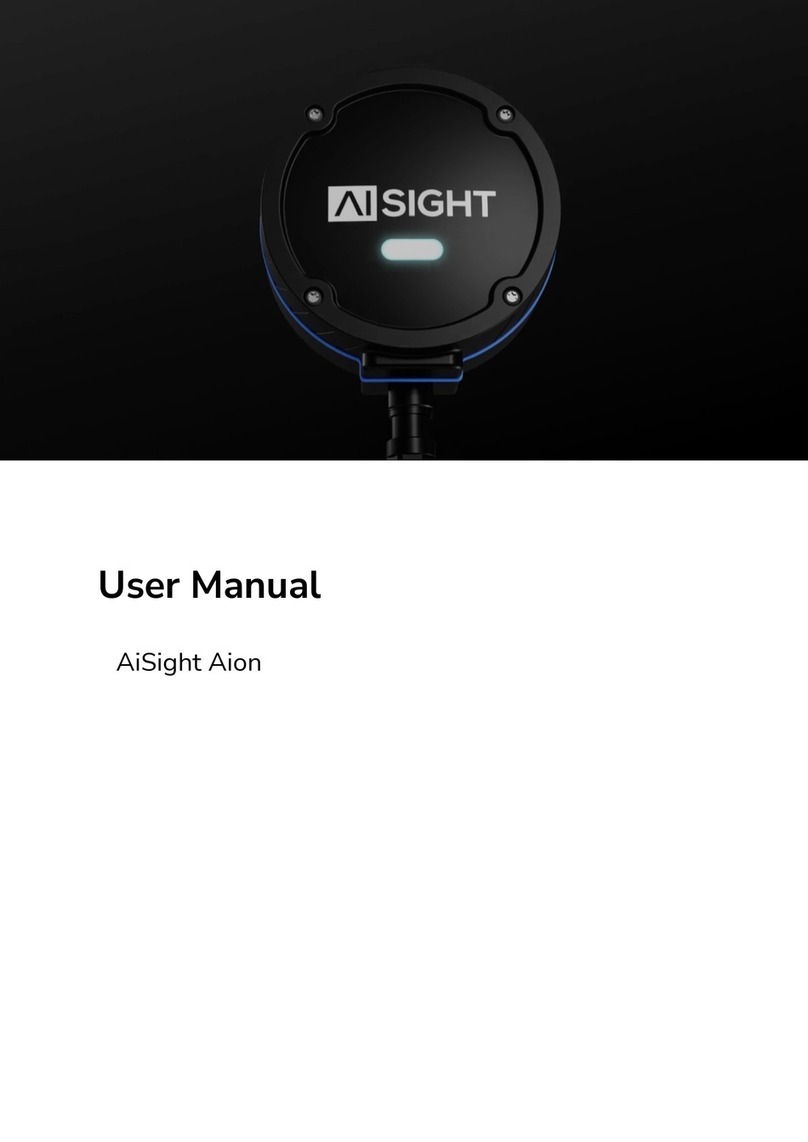
AiSight
AiSight Aion user manual
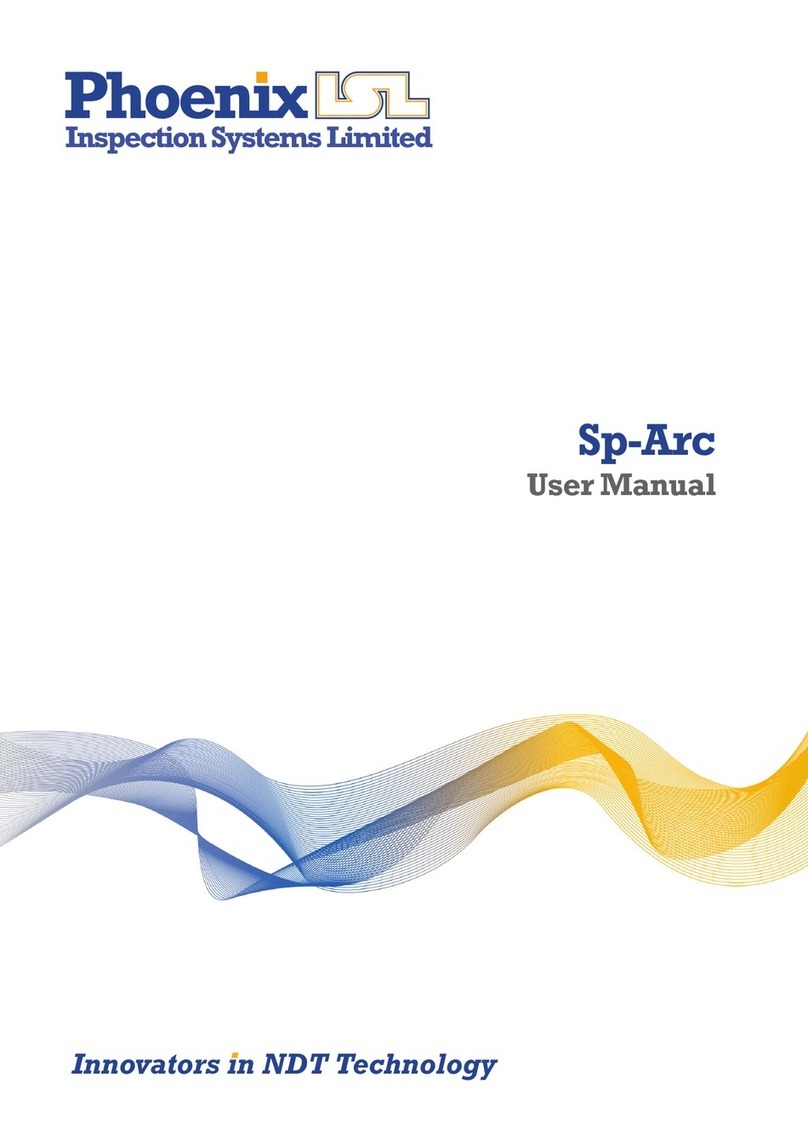
Phoenix ISL
Phoenix ISL SP-ARC user manual
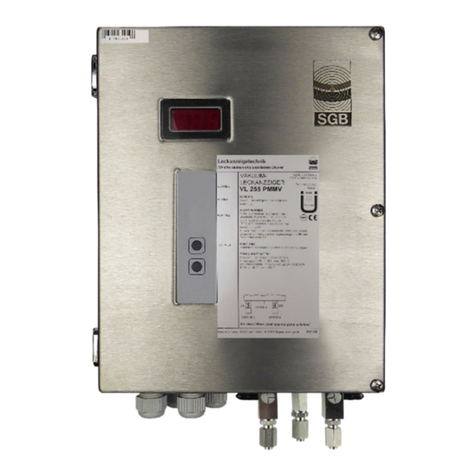
SGB
SGB VL Series Documentation
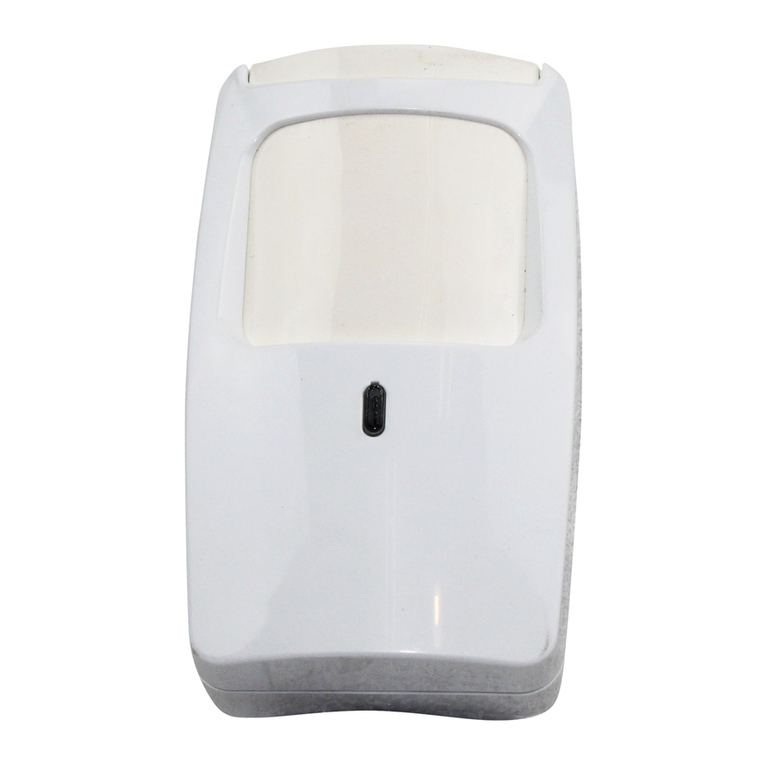
Honeywell
Honeywell DT7235T installation instructions
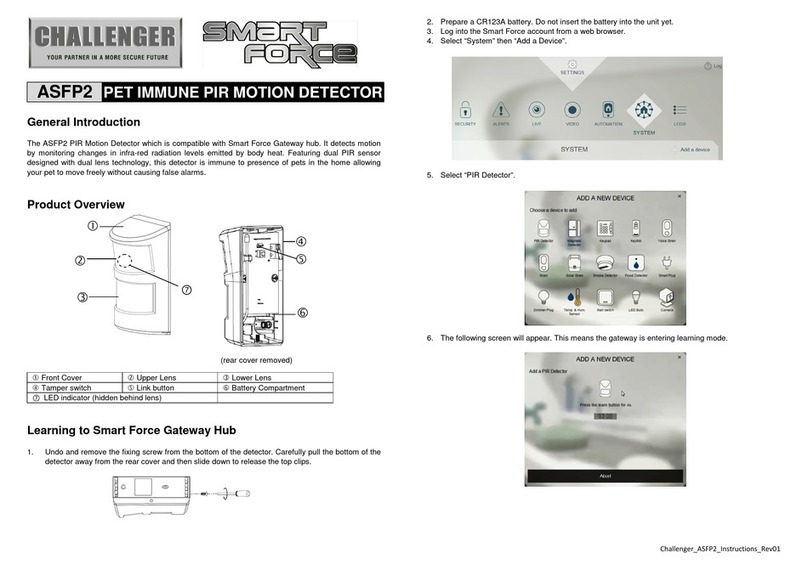
Challenger
Challenger Smart Force ASFP2 instructions
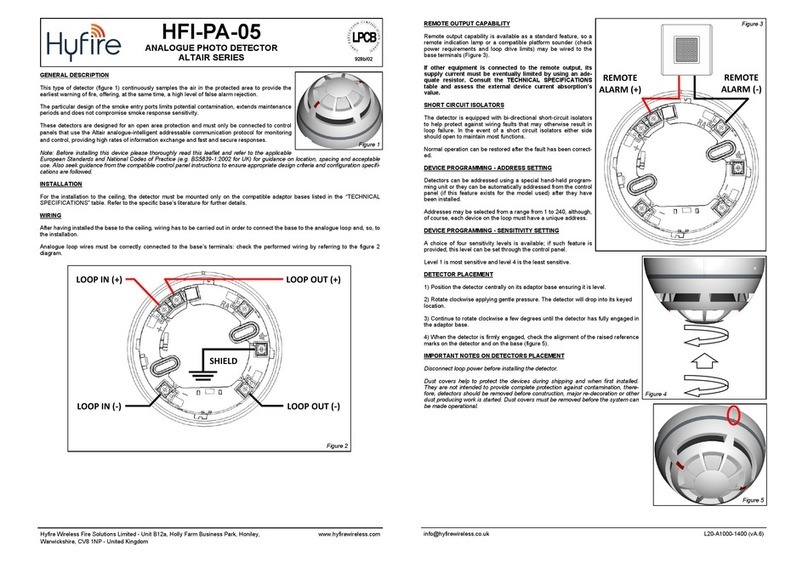
hyfire
hyfire ALTAIR HFI-PA-05 manual
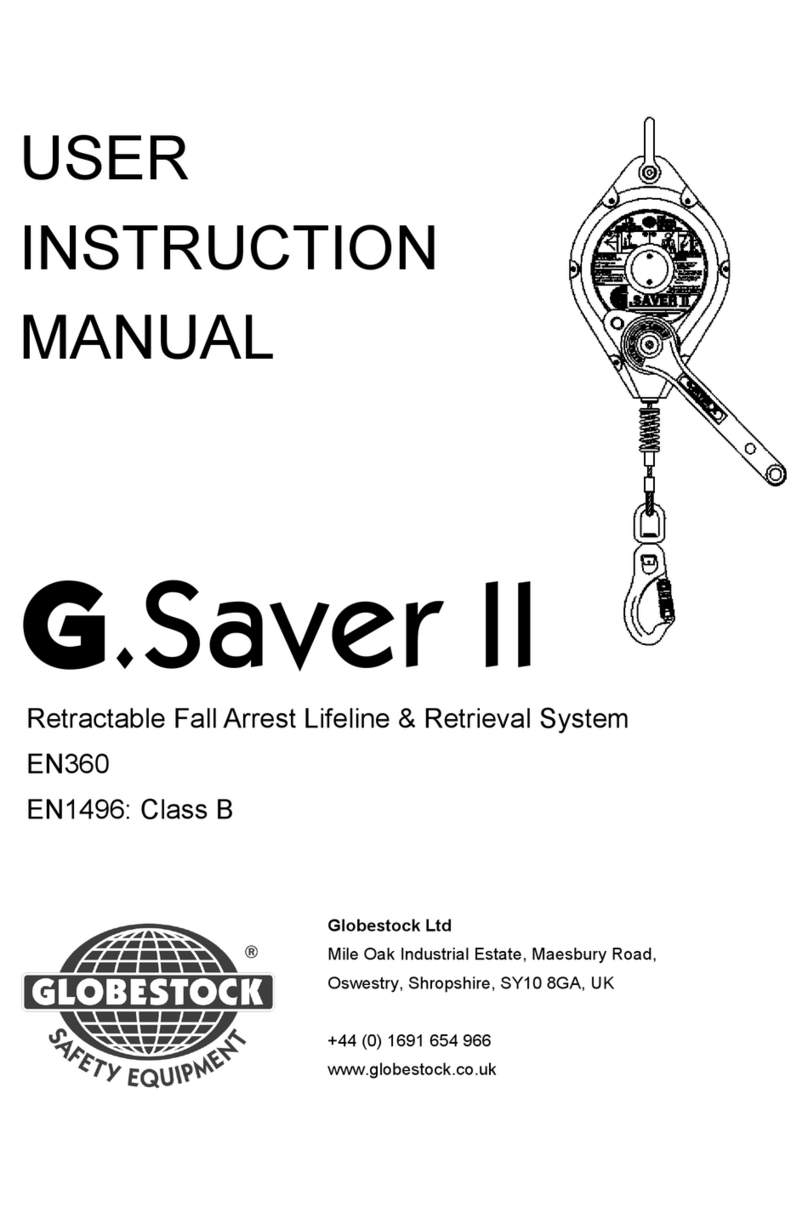
Globestock
Globestock G.Saver II User instruction manual
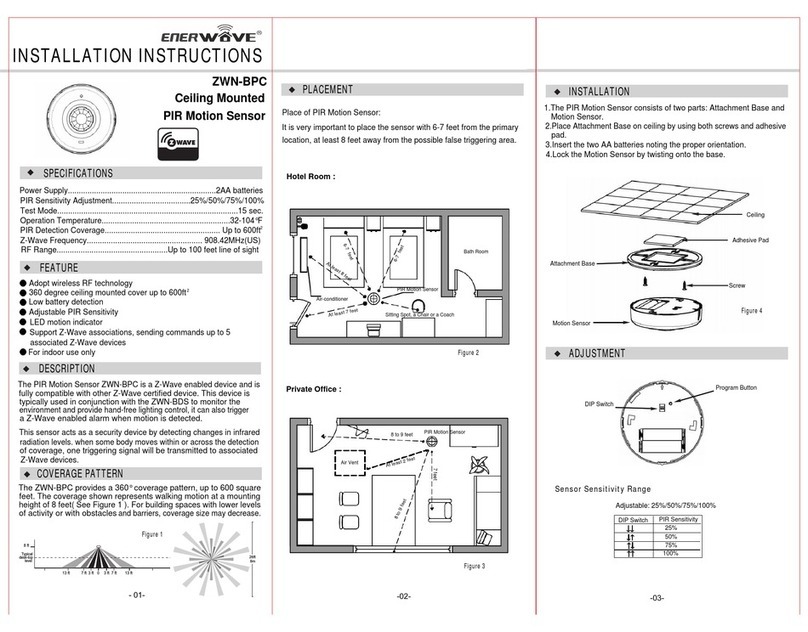
Enerwave
Enerwave ZWN-BPC installation instructions
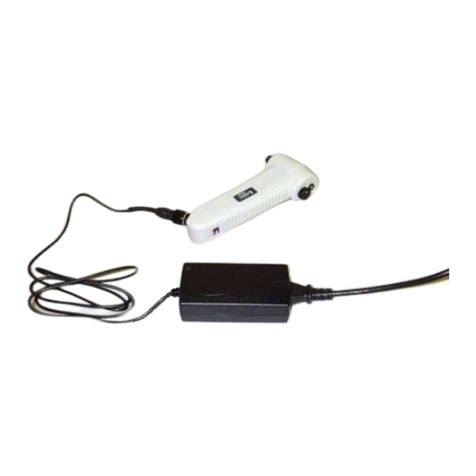
Palmer
Palmer Lmic operating manual
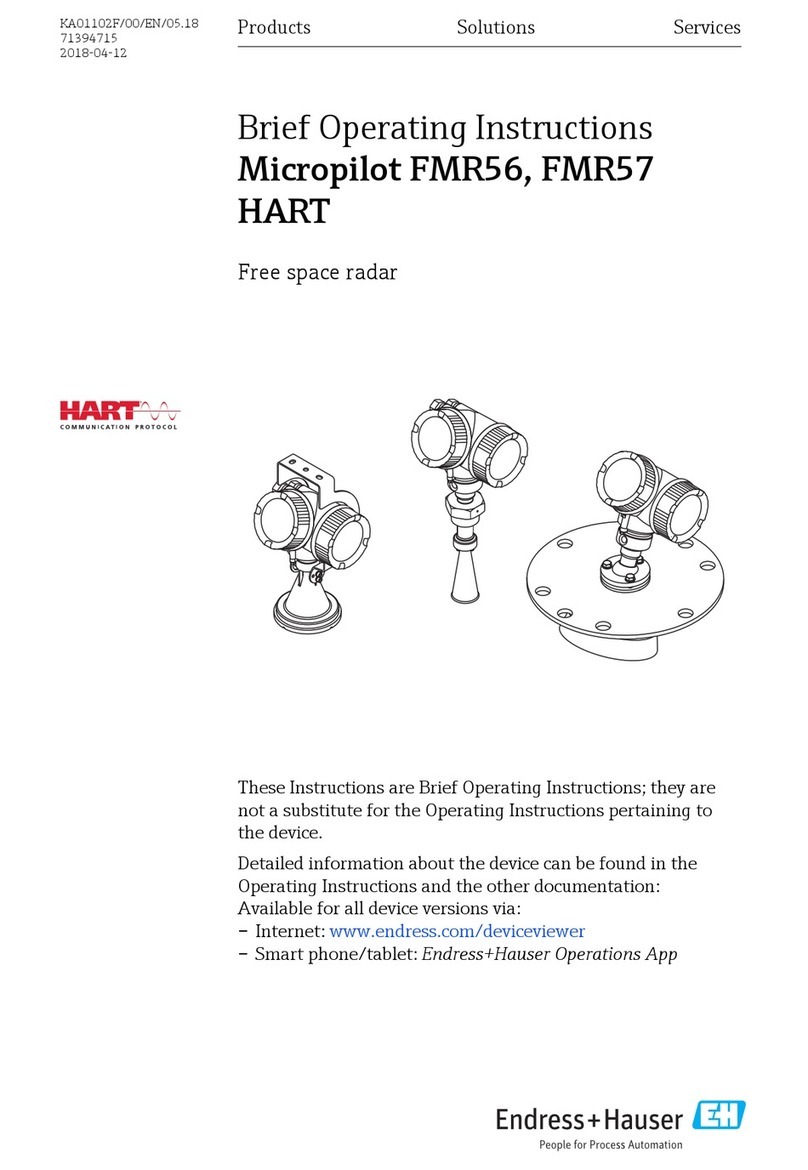
Endress+Hauser
Endress+Hauser Micropilot FMR56 Brief operating instructions
